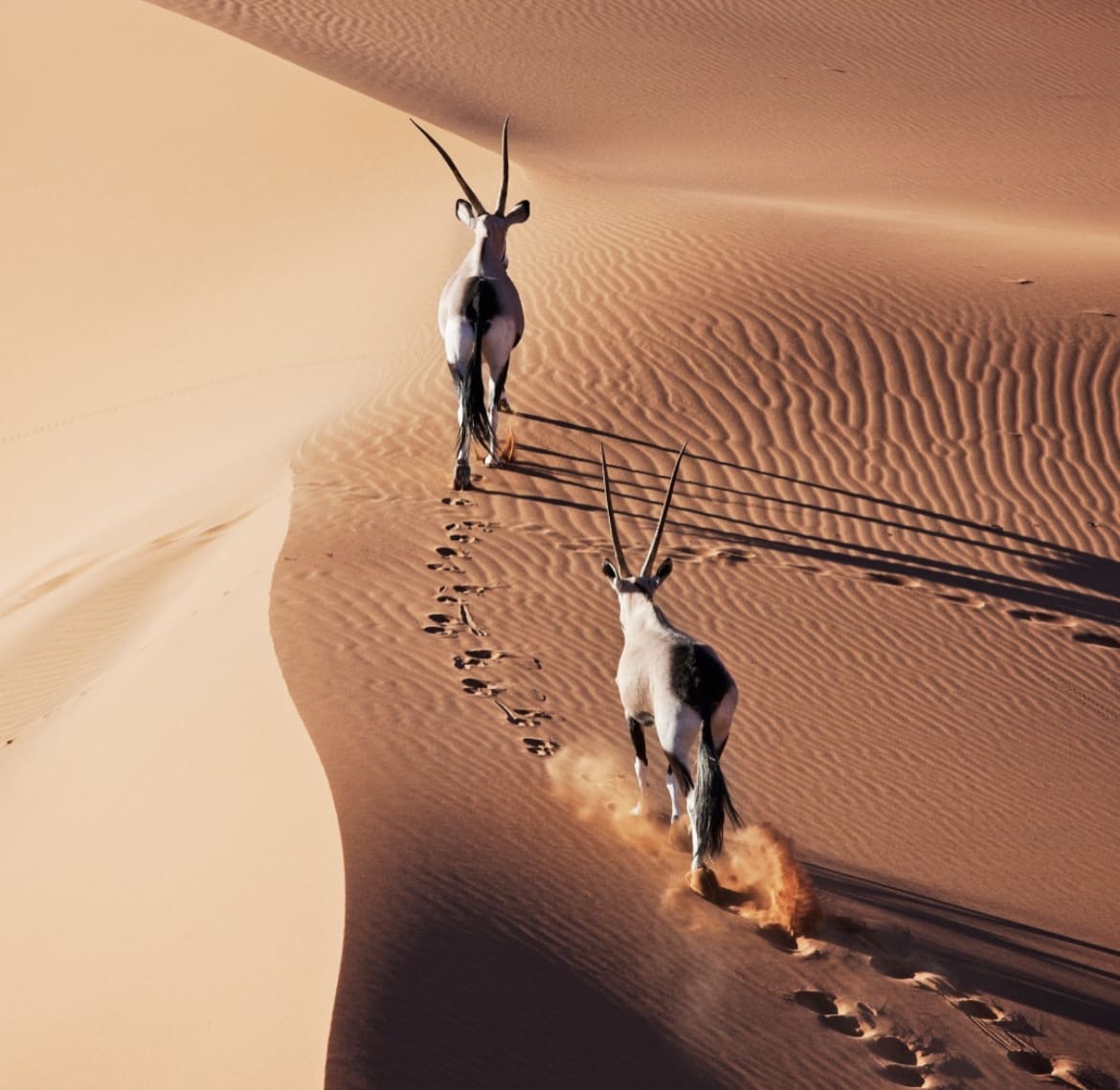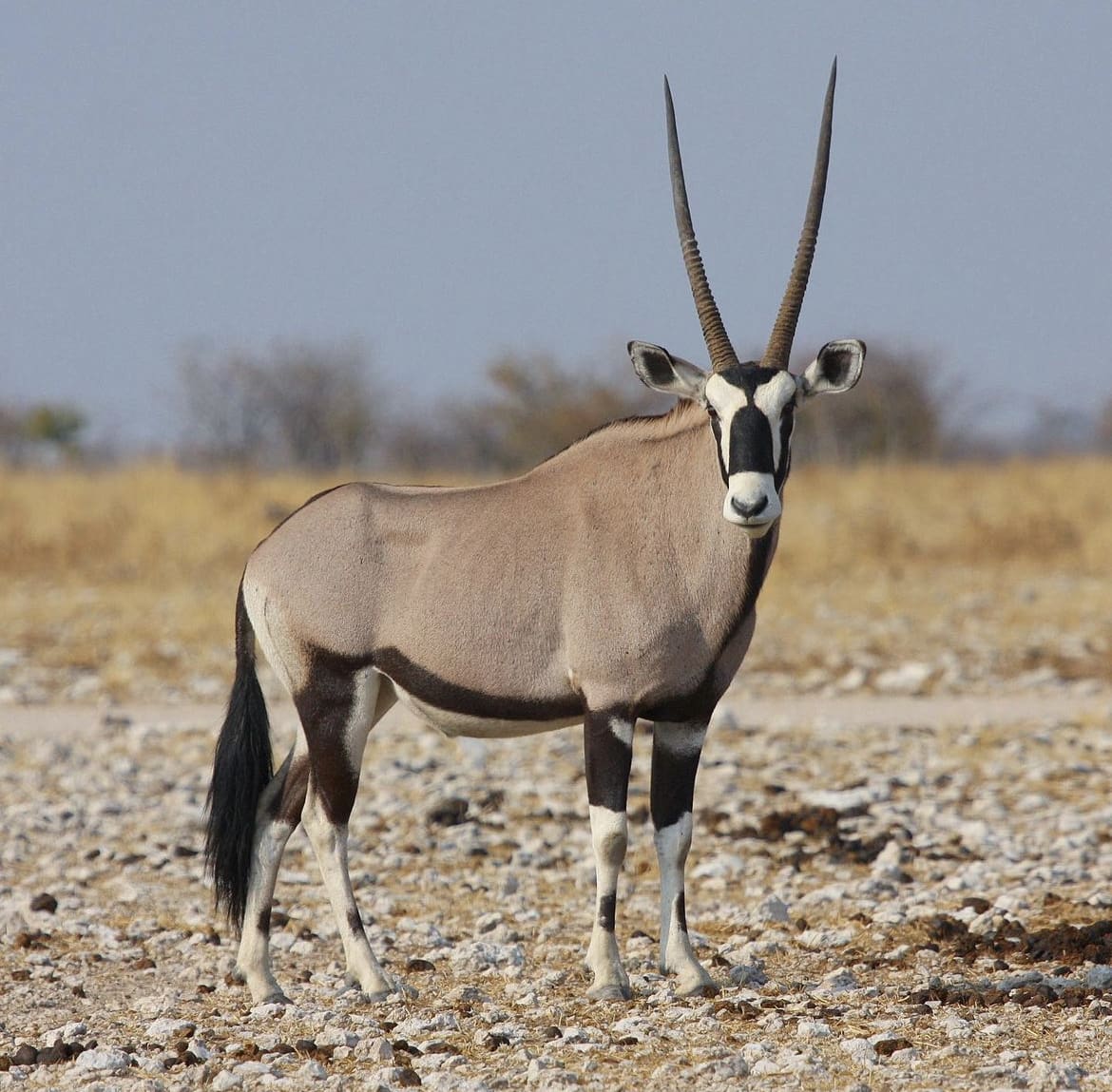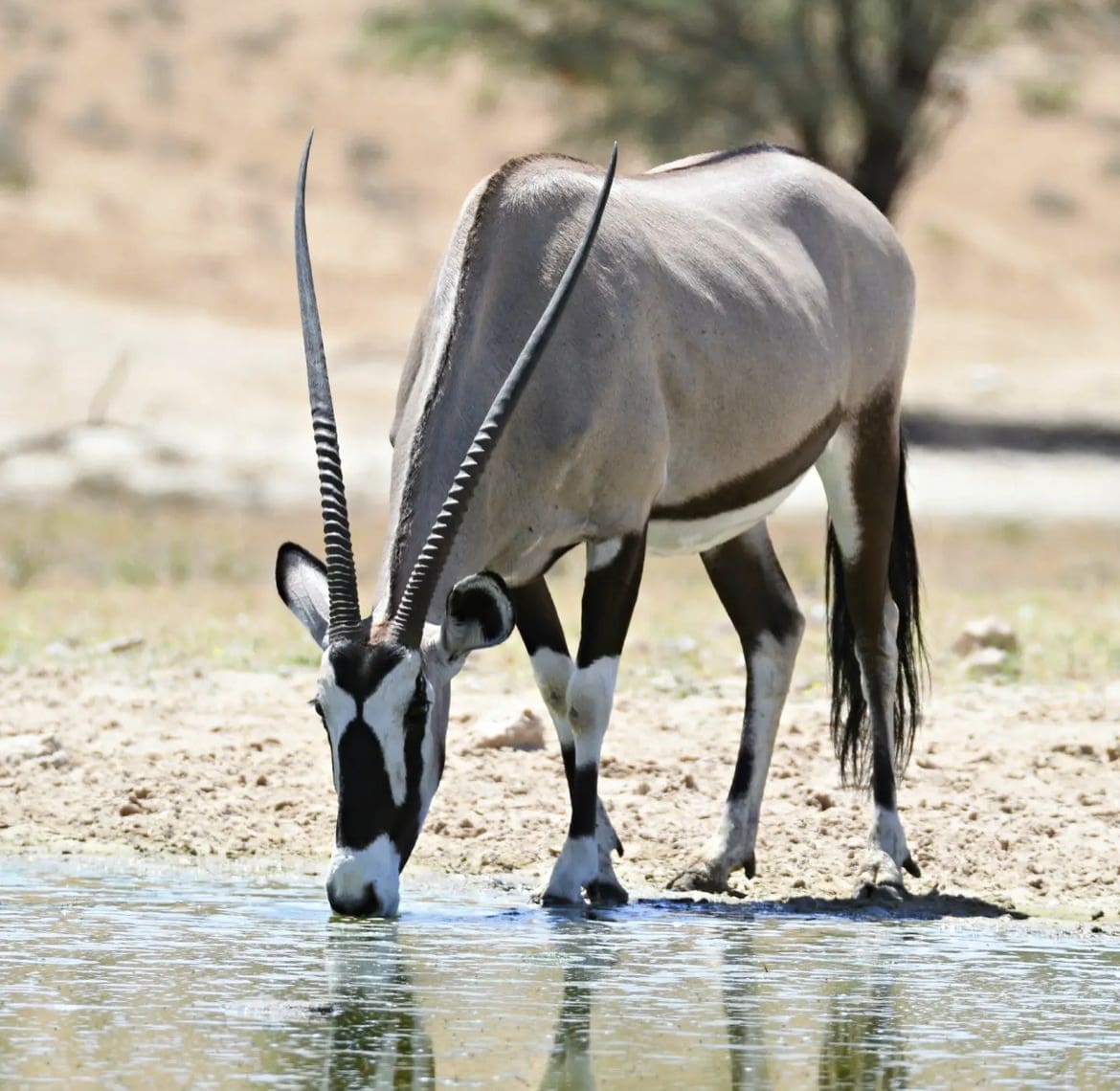The Gembsok, or Oryx, is one of Africa’s most striking and resilient creatures. This isn’t your average, run-of-the-mill antelope. Oh no, the Gemsbok is a symbol of the rugged, untamed landscapes it calls home.
What is the Gemsbok?
First off, the Gemsbok, or as the scientists like to call it, Oryx gazella, is not your backyard deer. This majestic beast is more like the warrior of the antelope world, built to survive in some of Africa’s harshest environments. Standing tall with a robust build, the Gemsbok is a testament to the adaptability and resilience of nature. And guess what? It’s not just surviving; it’s thriving, baby!
Native to the arid regions of Southern Africa, the Gemsbok has made places like the Kalahari Desert its playground. Imagine that – thriving in a sandbox that goes on for miles with water as scarce as a decent Wi-Fi signal in the middle of nowhere. But the Gemsbok doesn’t just survive; it struts its stuff with a grace that’s as mesmerizing as its habitat is merciless.
Gemsbok vs Oryx
Now, before we go any further, let’s clear up a little confusion. “Gemsbok” and “Oryx” are terms that often get tossed around interchangeably, but here’s the scoop. The word “Oryx” actually refers to a whole family reunion of antelopes that includes several species, with the Gemsbok being one of the VIP members. Think of Oryx as the last name and Gemsbok as the first name of our desert-dwelling pal.
The Gemsbok is specifically the Southern African flavor of Oryx, sporting some features that set it apart from its cousins like the Arabian Oryx (think of it as the Gemsbok’s distant, desert-dwelling second cousin twice removed). So, when we’re chatting about the Gemsbok here, we’re talking about the Oryx gazella, the epitome of desert chic and survival skills.

What do Gemsbok look like
Alright, let’s talk fashion and looks because, let’s face it, the Gemsbok could easily grace the cover of “Nature’s Vogue” if there was one. Standing up to 1.2 meters (about 4 feet) at the shoulder and rocking a body length that can stretch up to 2.4 meters (close to 8 feet), this antelope is not messing around. It’s got a physique that’s both athletic and elegant, built for endurance and speed.
But the real showstopper? Those horns. Gemsbok horns are like the samurai swords of the animal kingdom – long, sharp, and straight, stretching up to a whopping 1.2 meters (yeah, you read that right). Both males and females sport these impressive headpieces, making them one of the few democratic societies in the wild where everyone gets to look equally badass.
And let’s not forget their coat – a sleek, sandy to light brown getup that screams “desert chic.” Contrasting black and white markings adorn their face, legs, and rump, giving them that extra edge in the looks department. It’s not just about aesthetics, though; this color scheme is all about survival, helping them blend into their sandy surroundings and regulate their body temperature under the scorching sun.
How big are Oryx?
When it comes to size, Oryx don’t do things by halves. These creatures are the embodiment of strength and resilience, with adult Gemsbok typically weighing in between 180 to 240 kilograms (that’s around 400 to 530 pounds, folks).
Their robust build isn’t just for show; it’s a critical survival trait that helps them fend off predators and endure the harsh conditions of their environment. Imagine lugging that weight around the desert – these guys are the ultimate endurance athletes of the animal kingdom.

Gemsbok Skin
Now, let’s talk about the Gemsbok’s skin, because, in the desert, skin care is not just about looking good – it’s about survival. Their skin is thick and tough, a natural armor against the harsh sun and the abrasive sand of their desert home.
But it’s not just about protection; their light-colored coat reflects the sun’s rays, while the unique properties of their skin help them regulate their body temperature. In the scorching heat of the day, they can increase their body temperature to avoid sweating and conserve precious water. Talk about natural air conditioning!
Oryx Horns
Ah, the Oryx horns – the crowning glory of these magnificent beasts. Long, straight, and as sharp as they come, these aren’t just for show. Both males and females are equipped with these formidable weapons, which can reach lengths of up to 1.2 meters (almost 4 feet). These aren’t just for defending against predators; they’re also a critical part of the Gemsbok’s social interactions, used in battles for dominance within the herd.
But let’s be real, they also make the Gemsbok one of the most photogenic creatures out there. Can you imagine the selfies you could take with these guys? #HornGoals
Gemsbok Colouration
One of the most striking features of the Gemsbok is its distinctive colouration. This isn’t just about looking good for the animal paparazzi; it’s about survival. Their light brown or grey coat, marked with striking black and white patches, serves a dual purpose. It’s perfect for blending into their arid surroundings, a natural camouflage against both predators and prey.
These colors help regulate their body temperature, reflecting the blazing sun to keep cool. In the harsh, unforgiving desert, every detail of the Gemsbok’s appearance is a survival tool.

What do Oryx eat?
Now, onto the menu. What does an animal that lives in one of the most unforgiving environments on Earth eat? The Gemsbok’s diet is a testament to their adaptability. They are predominantly grazers but won’t say no to a bit of variety, munching on grasses, leaves, herbs, and even the occasional fruit and vegetable matter that can be found in their desert home.
Amazingly, they can go weeks, sometimes months, without water. They extract moisture from their food, a neat little survival trick that makes living in the desert a breeze. Well, as much of a breeze as it can be when you’re surrounded by sand and more sand.
Gemsbok Social Structure
When it comes to social life, Gemsbok are quite the community-oriented animals. They form groups called herds, which can range from a cozy gathering of a few individuals to a bustling community of up to 40 members. These herds are typically matriarchal, led by a dominant female who calls the shots. But don’t let their organized social structure fool you; Gemsbok are not always the peaceful neighbors they appear to be.
Males often engage in fierce battles for dominance, using their formidable horns as weapons. These confrontations, while serious, rarely result in serious injury, serving more as a demonstration of strength and hierarchy within the group.

How do Oryx reproduce?
When it comes to romance in the desert, Gemsbok have their unique rituals. The mating season isn’t just a time for finding love; it’s a critical period for ensuring the survival of their species. Males showcase their strength and vigor through displays of dominance, which include locking horns and engaging in power displays. It’s not just about brute force; it’s about proving potential as a mate and protector.
Females, on the other hand, are selective, choosing mates based on their demonstrations of strength and territory control. After a gestation period of about eight to nine months, a single calf is born. These newborns are hidden away for several weeks, a strategy to protect them from predators. During this crucial period, the mother visits her calf to nurse it, ensuring it gains the strength to join the herd. This careful nurturing ensures that even in the most unforgiving environments, the next generation of Gemsbok has a fighting chance at life.
How long do Gemsbok live?
Gemsbok are in it for the long haul. In the wild, these hardy creatures can live up to 20 years, a testament to their resilience and adaptability. Their lifespan is a reflection of their ability to navigate the challenges of their environment, from evading predators to finding sustenance in the sparse desert. In captivity, where threats are minimized, and resources are plentiful, they can live even longer.
This longevity is not just about survival; it’s about the Gemsbok’s role in their ecosystem, maintaining the delicate balance of their habitat over decades.

Are Oryx aggressive?
Now, let’s talk about the mood swings of the desert. Are Gemsbok the aggressive neighbors of the animal kingdom? Well, yes and no. Generally, Gemsbok are peaceful creatures, focused on grazing and socializing within their herds. However, when threatened, they don’t shy away from throwing down. Their long, sharp horns aren’t just for decoration; they’re formidable weapons against predators and rivals. Males, in particular, can become aggressive during mating season, as they vie for dominance and the attention of females.
But it’s not all about brawn; Gemsbok have a complex system of communication and social interaction that helps prevent unnecessary conflicts. From body postures to vocalizations, they have ways of saying, “Back off, buddy,” without resorting to violence. It’s this balance of strength and social intelligence that keeps the peace in the Gemsbok world.
Are Gemsbok territorial?
In the expansive deserts and savannahs, where resources are as scarce as a cool breeze, the Gemsbok’s approach to territory is both pragmatic and strategic. Yes, Gemsbok can be territorial, but not in the way you might think. They don’t guard vast swathes of land with a “keep off the grass” sign. Instead, their territorial behavior is more about resource control—specifically, access to precious water sources and the best grazing areas.
Dominant males stake claim to territories that offer these essential resources, and they’ll defend these gold mines against rivals. But here’s where it gets interesting: their territorial disputes are often more about posturing and intimidation than actual combat. Think of it as a high-stakes game of chicken, where the winner takes all without throwing a punch. This strategy not only conserves energy but also reduces the risk of injury, ensuring that the Gemsbok can continue to thrive in their harsh homeland.

How fast are Gemsbok?
When danger looms on the horizon, the Gemsbok doesn’t just stand around waiting for a miracle. These creatures are built for speed, capable of sprinting up to 60 kilometers per hour (about 37 miles per hour). Their long, slender legs are not just for show; they’re the engines that power these impressive bursts of speed.
Whether evading predators or competing with each other, their agility and endurance are key to their survival. This speed, combined with their stamina, allows them to traverse the vast distances of their habitats, from the dunes of the Namib to the plains of the Kalahari, with grace and efficiency.
Where do Gemsbok live?
Speaking of habitats, let’s talk about the real estate preferences of the Gemsbok. These adaptable creatures call some of Africa’s most arid and inhospitable regions home. From the sandy wastes of the Kalahari Desert to the rocky outcrops of the Namib, Gemsbok thrive in environments that would be uninhabitable for most. Their presence in these regions is a striking testament to their adaptability, finding nourishment and water in landscapes that offer little respite from the relentless sun.
But their habitat isn’t just about survival; it’s about belonging. The Gemsbok is an integral part of these ecosystems, playing a crucial role in the balance of life in these stark landscapes. Their grazing habits help shape the vegetation, while their existence supports a range of predators and scavengers. In essence, the Gemsbok is a cornerstone of their ecosystems, contributing to the biodiversity and health of their habitats.
How many Gemsbok are there in the wild?
Determining the exact number of Gemsbok in the wild is a challenging endeavor, given the vast and often inaccessible territories they inhabit. However, it’s believed that the Gemsbok population remains relatively stable, particularly in protected areas and reserves where they are safeguarded from the brunt of human encroachment and other threats.
Conservation efforts and wildlife management strategies have played a crucial role in maintaining healthy populations of these magnificent creatures. Yet, the need for continuous monitoring and protection is ever-present, as external pressures on their habitats and populations persist.

Are Gemsbok endangered?
Currently, the Gemsbok is classified as a species of Least Concern by the International Union for Conservation of Nature (IUCN), indicating that, for now, they are not at immediate risk of extinction. This status is a testament to their adaptability and the effectiveness of conservation measures in place within their range.
However, complacency is not an option. The Gemsbok’s survival story is far from secure, with ongoing challenges that threaten their future. Conservationists and wildlife managers continue to advocate for the protection of Gemsbok habitats and the implementation of sustainable practices to ensure these icons of the desert persist for generations to come.
Threats to Gemsbok in the wild
The threats facing Gemsbok in their natural habitats are multifaceted, ranging from environmental to anthropogenic pressures. Habitat loss and fragmentation, due to agricultural expansion and infrastructural development, pose significant risks, encroaching upon the natural landscapes Gemsbok call home. Climate change exacerbates these challenges, altering the ecosystems in which they thrive and putting additional stress on their water and food sources.
Poaching and illegal hunting, though less prevalent in well-protected areas, remain concerns, particularly in regions where law enforcement and conservation resources are limited. Competition with livestock for scarce resources can also lead to conflicts, further straining the delicate balance between humans and wildlife in these arid regions.
Where to see Gemsbok in the wild
For those yearning to witness the majesty of the Gemsbok firsthand, there are several wildlife reserves and national parks across Southern Africa where these magnificent creatures roam freely.
The Kgalagadi Transfrontier Park, straddling the borders of South Africa and Botswana, offers vast expanses of semi-arid desert landscapes where Gemsbok are a common sight. Namibia’s Namib-Naukluft National Park and the Central Kalahari Game Reserve in Botswana are also prime locations to observe Gemsbok in their natural environment, living testament to the endurance of life in the desert.

Tips for spotting Gemsbok in the wild
Spotting Gemsbok in the vast wilderness requires patience, respect for nature, and a bit of know-how. Here are some tips for wildlife enthusiasts:
- Early mornings and late afternoons are your best bet. Gemsbok are most active during the cooler parts of the day, making these ideal times for sightings.
- Keep a respectful distance. While observing these magnificent creatures, it’s crucial to maintain a safe distance to avoid disturbing them or their natural behaviors.
- Look for waterholes. In the arid environments they inhabit, Gemsbok often congregate around water sources, especially during dry seasons.
- Use binoculars or a camera with a good zoom lens. This allows you to observe and capture the beauty of the Gemsbok without needing to get too close.
- Hire a local guide. Their expertise and knowledge of the area can greatly enhance your chances of spotting Gemsbok and understanding their behaviors.
Facts about The Gemsbok
- Gemsbok can survive in temperatures exceeding 40°C (104°F) thanks to their unique adaptations.
- Both male and female Gemsbok sport long, sharp horns, a rare trait among antelopes.
- They can go weeks without water, obtaining moisture from the plants they eat.
- Gemsbok are capable of running at speeds up to 60 km/h (37 mph), making them one of the fastest desert animals.
Myths about The Gemsbok
- Myth: Gemsbok use their horns to dig for water. Reality: While their horns are formidable, they are primarily used for defense and social dominance, not for digging.
- Myth: Gemsbok can survive indefinitely without water. Reality: While they have remarkable adaptations for minimizing water loss, they still need to drink when water is available.
- Myth: Gemsbok are solitary animals. Reality: They are highly social and often found in herds, demonstrating complex social structures.
